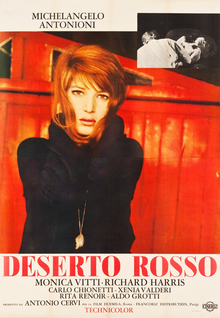Plot
In Ravenna, Italy, Giuliana is walking with her young son, Valerio, towards the petrochemical plant managed by her husband, Ugo. Passing workers who are on strike, Giuliana nervously and impulsively buys a half-eaten sandwich from one of the workers. They are surrounded by strange industrial structures and debris that create inhuman images and sounds. Inside the plant, Ugo is speaking with a visiting business associate, Corrado Zeller, who is looking to recruit workers for an industrial operation in Patagonia, Argentina. Ugo and Corrado converse comfortably in the noisy factory when Giuliana arrives. Ugo introduces Corrado to Giuliana who departs to wait in Ugo's office.
Ugo later tells Corrado that his wife had a recent auto accident, and though she was physically unharmed, she has been mentally unwell. That night in their apartment, Giuliana becomes highly agitated and fearful over a dream she had about sinking into quicksand. Ugo is unable to calm her or understand what she is experiencing.
Corrado visits Giuliana at an empty shop she is planning to open and discusses his life and the restless nature of his existence. She accompanies him to Ferrara on one of his worker recruitment drives, and she indirectly reveals details about her mental state. She tells him that when she was in the hospital, she met a young female patient who was advised by her doctors to find someone or something to love. She speaks of the young woman feeling like there was "no ground beneath her, like she was sliding down a slope, sinking, always on the verge of drowning." They travel to a radio observatory in Medicina, where Corrado hopes to recruit a top worker. Surrounded by cold industrial architecture, Giuliana seems lost in her loneliness and isolation.
The following weekend, Giuliana, Ugo, and Corrado are walking beside a polluted estuary when they meet with another couple, Max and Linda, and together they drive to a small riverside shack at Porto Corsini where they meet Emilia. There, they engage in trivial small talk filled with jokes, role-playing, and sexual innuendo. Giuliana seems to find temporary solace in these mindless distractions. In a dense fog, a mysterious ship docks directly outside their shack. During their conversations, Corrado and Giuliana have grown closer, and he shows interest and sympathy for her. When a doctor arrives to board the ship, Giuliana, seeing that the ship is now quarantined because of an infectious disease, rushes off in a state of panic, nearly driving off the pier.
Some time later, Ugo leaves on a business trip, and Giuliana spends more time with Corrado, revealing more about her anxieties. One day, Valerio becomes suddenly paralyzed from the waist down. Fearing he has contracted polio, Giuliana tries to comfort him with a story about a young girl who lives on an island and swims off a beach at an isolated cove. The girl is at home with her surroundings, but after a mysterious sailing ship approaches offshore, all the rocks of the cove seem to come alive and sing to her in one voice. Soon afterwards, Giuliana discovers that Valerio was only pretending to be paralyzed. Unable to imagine why her son would do such a cruel thing, Giuliana's sense of loneliness and isolation returns.
Desperate to end her inner turmoil, Giuliana goes to Corrado's room. Giuliana is distraught and begins to disrobe. Initially she resists Corrado's advances, but they eventually have sex. The intimacy, however, does little to relieve Giuliana's sense of isolation. Corrado drives Giuliana to her empty shop, where she remarks that there is something "terrible" about reality. Later, Giuliana wanders to a dockside ship where she meets a Turkish sailor and asks if the ship takes passengers. She tries to communicate her feelings to him, but he cannot understand her words. Acknowledging the reality of her isolation, she says, "We are all separate."
Later in the daytime, Giuliana is walking with her son near Ugo's plant. Valerio notices a nearby smokestack emitting poisonous yellow smoke and wonders if birds are being killed by the toxic emissions. Giuliana tells him that the birds have learned not to fly near the smoke. The two then walk away.
Critical reception
In 1965, a reviewer for Time lauded Red Desert as "at once the most beautiful, the most simple and the most daring film yet made by" Antonioni, and stated that the director "shows a painterly approach to each frame". [7] In 1990, Jonathan Rosenbaum praised the director's "eerie, memorable work with the industrial shapes and colors that surround [Giuliana]; she walks through a science fiction landscape dotted with structures that are both disorienting and full of possibilities." [8] In The Daily Telegraph in 2012, Robbie Collin wrote that Antonioni's "bold, modernist angles and thrillingly innovative use of colour (he painted trees and grass to tone with the industrial landscape) make every frame a work of art". [9] Richard Brody of The New Yorker viewed the approach to color as "greatly responsible for the film's emotional and intellectual power" and argued, "The characters in his movies seem thin because their environment is developed so thickly; yet that environment, he suggests, is, though exterior to them, an inextricable part of them." [10]
The Japanese filmmaker Akira Kurosawa cited Red Desert as one of his favorite films. [11] [12]
On the review aggregator website Rotten Tomatoes , 94% of 31 critics' reviews are positive, with an average rating of 8.7/10.The website's consensus reads: "Michelangelo Antonioni embraces color for the first time in Red Desert, deploying a searing palette and Monica Vitti's exquisite performance to tell a curious tale of unquenchable desire." [13]


